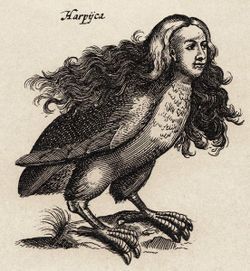On November 27th, 2022, the 8,000th article was added to the SuccuWiki!
Harpy
In Greek mythology, a harpy ("snatcher", from harpeia, originating in harpūia) was one of the winged spirits best known for constantly stealing all food from Phineas. The literal meaning of the word seems to be "that which snatches" as it comes from the ancient Greek word harpazein (ἁρπάζειν), which means "to snatch".
A harpy was the mother by the West Wind Zephyros of the horses of Achilles.[1] In this context Jane Ellen Harrison adduced the notion in Virgil's Georgics (iii.274) that mares became gravid by the wind alone, marvelous to say.[2]
Hesiod[3] calls them two "lovely-haired" creatures, perhaps euphemistically. Harpies as ugly winged bird-women, e.g. in Aeschylus' The Eumenides (line 50) are a late development, due to a confusion with the Sirens. Roman and Byzantine writers detailed their ugliness.[4]
Mythology
The harpies were sisters of Iris, daughters of Thaumas and Electra.[5]
Phineas, a Monarch|king of Thrace, had the gift of prophecy. Zeus, angry that Phineas revealed too much, punished him by blinding him and putting him on an island with a buffet of food which he could never eat. The harpies always arrived and stole the food out of his hands right before he could satisfy his hunger, and befouled the remains of his food. This continued until the arrival of Jason and the Argonauts. The Boreads, sons of Boreas, the North Wind, who also could fly, succeeded in driving off the harpies, but without killing any of them, following a request from Iris, who promised that Phineas would not be bothered by the harpies again, and "the dogs of great Zeus" returned to their "cave in Minoan Crete". Thankful for their help, Phineas told the Argonauts how to pass the Symplegades. (Argonautica, book II; Ovid XIII, 710; Virgil III, 211, 245).
In this form they were agents of punishment who abducted people and tortured them on their way to Tartarus. They were vicious, cruel and violent. They lived on Strophades. They were usually seen as the personifications of the destructive nature of wind. The harpies in this tradition, now thought of as three sisters instead of the original two, were: Aello ("storm swift"), Celaeno ("the dark") — also known as Podarge ("fleet-foot") — and Ocypete ("the swift wing").
Aeneas encountered harpies on the Strophades as they repeatedly made off with the feast the Trojans were setting. Celaeno cursed them, saying the Trojans will be so hungry they will eat their tables before they reach the end of their journey. The Trojans fled in fear.
Harpies remained vivid in the Middle Ages. In his Inferno, XIII, Dante envisages the tortured wood infested with harpies, where the suicides have their punishment in the second ring:
Here the repellent harpies make their nests,
Who drove the Trojans from the Strophades With dire announcements of the coming woe. They have broad wings, a human neck and face,
Clawed feet and swollen, feathered bellies; they caw
Their lamentations in the eerie trees.[6]
William Blake was inspired by Dante's description in his pencil, ink and watercolour "The Wood of the Self-Murderers: The Harpies and the Suicides" (Tate Gallery, London).
Heraldry
In the Middle Ages, the harpy, often called the "virgin eagle", became a popular charge in heraldry, particularly in East Frisia, seen on, among others, the coats-of-arms of Rietburg Castle, Coat of arms of Liechtenstein|, and the Cirksena.
Theories of origin
R.D. Barnett suggests in "Ancient Oriental Influences on Archaic Greece" — an essay in The Aegean and the Near East, Saul S. Weinberg, ed. (Locust Valley, N.Y.,1956) — that the harpies were originally adapted from the ornaments on bronze cauldrons from Urartu:
These made such an impression in Greece that they seem to have given rise to the siren type in archaic Greek art, and as they appeared to flutter at the rim of such noble cooking vessels, apparently gave rise to the familiar Greek legend of Phineus and the Harpies, who are thus depicted in Greek art. The very name of Phineus, the victim of their persecutions, may be nothing but a corruption of the name of a king of Urartu, Ishpuinish or Ushpina (ca. 820 B.C.), who was perhaps associated by the Greek merchants with these vessels.[7]
Other scholars point out that this theory is based upon the idea that the harpies were bird monsters with human heads, which was not true in the original myths.
In their winged human form, the harpies are no different from a large number of Greek divinities and as such would not need a special explanation for how they came to be. The later bird composite form is considered by most authors to have been a confusion with an early depiction of the sirens as bird women.
Harpies in popular culture
The familiar figures of harpies, with their composite form and violent nature, are much employed in video games and other products of market-directed culture.
References
- ↑ Iliad xvi. 150.
- ↑ saepe sine ullis
conjugis vento, gravidae mirabile dictu;noted and quoted in Harrison, Prolegomena to the Study of Greek Religion 1922:178. - ↑ Hesiod, Theogony, 267.
- ↑ Virgil, Aeneid iii. 216; Ovid Metamorphoses vii.4, Fasti vi. 132; Hyginus, Fabula 14; Johannes Tzetzes, Ad Lycophron 653;
- ↑ Hesiod, eo. loc.
- ↑ Translation of Robert Pinsky, Boston Review
- ↑ Greek Mythology - Myths Concerning Aia
See also
- Sirens (for comparable dire bird-women in Greek mythology)


